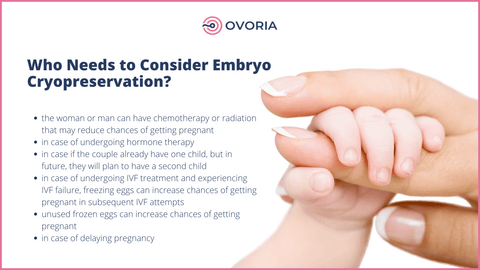Embryo Cryopreservation: What is Embryo Cryopreservation?
Thanks to the rapid development in assisted reproductive technologies, there are many fertility treatments for struggling with infertility issues:
- In Vitro fertilization (IVF): In-vitro fertilization involves the incubation of eggs and sperm from a couple in a laboratory to produce an embryo. Then a fertility doctor will place the embryo into the woman's uterus, where it may implant and result in a successful pregnancy
- Intrauterine insemination: IUI is a type of artificial insemination that involves placing sperm into a uterus using a thin tube.
- Third Party-Assisted ART: This type of assisted reproductive technology include egg donation, sperm donation, embryo donation, surrogated carries
Also, assisted productive technology offers such procedures as embryo cryopreservation, which has a list of benefits for couples who want to have a family in their 40s because building a meaningful and successful career or for teams where partners will have treatment can reduce fertility success chances.

What is Embryo Cryopreservation?
Embryo cryopreservation involves freezing and storing embryos. After they are thawed, they can be used in vitro fertilization. Cryopreservation is an integral and important part of most IVF programs. There are two methods of freezing in the In Vitro Fertilization laboratories:
- Slow freezing
- Vitrification
Cryopreservation allows a woman to have a stable number of embryos available for transfer in a fresh cycle and have quality embryos stored for a future pregnancy attempt.
Who Needs to Consider Embryo Cryopreservation?
There are many reasons why women and men can or need to consider cryopreservation:
- The woman or man can have chemotherapy or radiation that may reduce chances of getting pregnant
- In case of undergoing hormone therapy
- In case if the couple already have one child, but in future, they will plan to have a second child
- In case of undergoing IVF treatment and experiencing IVF failure, freezing eggs can increase chances of getting pregnant in subsequent IVF attempts
- Unused frozen eggs can increase chances of getting pregnant
- In case of delaying pregnancy

What is The Process of Cryopreservation?
To freeze eggs, women will need daily injections of gonadotropins for stimulating the growth of ovarian follicles (oocytes). Once eggs are detected by our fertility doctor using ultrasound imaging, they are retrieved transvaginally. Usually, embryos are frozen when fertilized by a partner's sperm or frozen when they become blastocysts about six days later.
Cryopreservation is accomplished by freezing eggs at a very rapid rate. Vitrification is the process that is almost guaranteed to prevent damage to eggs when other freezing functions may not. The vitrification method can improve the success rate of pregnancy for women who use frozen eggs.
Eggs can be frozen to a shallow temperature of -320 degrees Fahrenheit. Protective agents help further prevent damage to eggs during and after vitrification. Although it's unknown how long eggs can be frozen before they become unusable, fertility doctors recommend freezing eggs for ten years.

